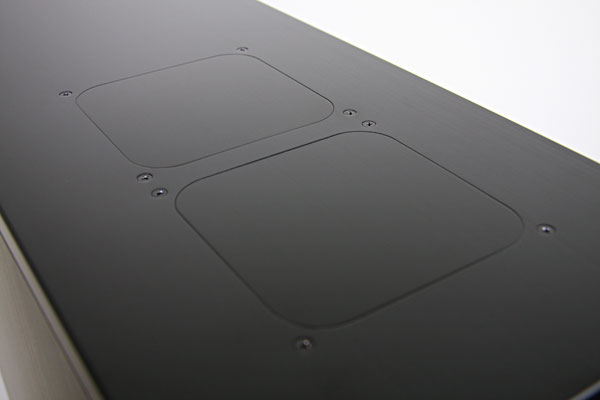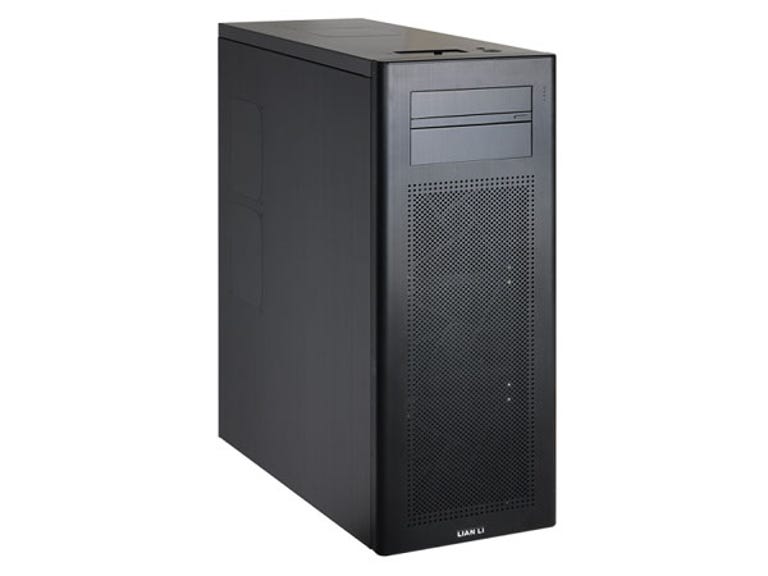 Why You Can Trust CNET
Why You Can Trust CNET Lian Li PC-A75 review: Lian Li PC-A75
Lian Li still builds the most elegant cases in the market. The PC-A75's biggest problem is that for AU$100 less, you can get a more innovative, refined steel case whose only sin is that it's heavier.
Despite the trend toward cheaper steel construction, Lian Li is still doing the aluminium thing. It does drive up the price markedly, but we appreciate how much lighter its cases are, especially when it comes to transporting them.
The Good
The Bad
The Bottom Line
Its newest outing, the PC-A75 (and the A76, which is the same thing but with a front door), is a full tower monolith that can take up to HPTX boards. It's a lesson in austerity, and yet it looks incredibly refined. At least, it does at first glance, but upon deeper inspection it's clear that shortcuts have been taken. More on that later.
The top of the case has two 120mm fan mounts, and to get access to them you'll need to unscrew two faceplates first. There are another two 140mm mounts on the side, but Lian Li only supplies grilles for the 120mm holes — to protect your fingers on the 140mm model, you'll need to buy aftermarket.

The two cut-outs at the top for 120mm fans.
(Credit: Craig Simms)
Lian Li provides mounting points for two 140mm fans on the side, but no protective grilles.
(Credit: Craig Simms)
The power and reset buttons are top mounted and open to prying fingers, but the ports are hidden beneath a sliding door. There are two USB 3.0 ports here, two USB 2.0 ports, headphone and microphone jacks and a gaping hole. We're guessing that there was meant to be an eSATA port there, but it's simply missing in our review sample. Lian Li includes a USB 3.0 to USB 2.0 converter, but the pins are exposed on the USB 3.0 side, which is a little cheap for a premium case.
A hole where eSATA most likely should be.
(Credit: Craig Simms)
The front panel comes off easily, and, if anything, this will be the part of the case to rattle, especially if not seated properly. You'll find three filtered, 140mm fans here, which are easily removed by pushing to the right. Lian Li throws in a universal aluminium cover for your optical drive, to help it blend in with the case design better.
The front 140mm fans are easily removed by sliding sideways.
(Credit: Craig Simms)
Lian Li includes a universal optical drive cover.
(Credit: Craig Simms)
Thumbscrews hold in the sides, and these are protected by rubber washers so as not to damage the black aluminium. Lift off the main side panel, and you'll be greeted by a removable bar that runs the height of the case, which is used to help hold expansion cards in place. While there's space for 11 expansion cards (and 11 PCI expansion slots to match, along with mounts for an optional quick-release mechanism), Lian Li only provides four plastic expansion card holders. If you have more, you're expected to buy more from Lian Li. Two plastic stoppers are included, which can be attached to the end of two of the plastic holders, in order to hold wider cards in place.
The bar that runs vertically down the middle of the case provides the space to add card holders.
(Credit: Craig Simms)
Sometimes pictures work better than words. Here are the plastic card holders and the plastic stopper at the end, in case you have a wide card — like a dual-slot graphics card.
(Credit: Craig Simms)
The second thing you'll notice are the rubber grommets that Lian Li has used for the cable pass-through holes on its motherboard tray; they're grey, they're misaligned and they look incredibly cheap. There are only three cable-management holes, too, which is a little difficult for a case of this size. It's a pale imitation of what cheaper cases give you — as though Lian Li is watching the market, but doesn't understand.
This applies to the two 20mm water-cooling holes at the back, too; they're not rubber, but hard plastic, and they easily push out of place when you push something through. Below this, you'll find a 120mm extraction fan, which has an audible drone to it — silence freaks will want to replace this. The 140mm fans at the front have a similar sonic signature, but their larger diameter quietens things enough so that it's not obnoxious.
Hard plastic grommets aren't exactly the best thing for soft pipes, and they pop out too easily.
(Credit: Craig Simms)
Lian Li's hard-drive rack, although non-removable, does feature a rather fancy locking mechanism. After outfitting your hard drives with vibration-dampening screws, you can then push them into place, and lower a slide rail down the side to lock things in. This mechanism prevents 2.5-inch drives such as SSDs from being mounted in the same way, so Lian Li has included three fixed plates, equidistant from each other, where SSDs can be attached. It's not ideal in terms of flexibility, but it does the job. If you don't use these SSD plates, the case will take 12 3.5-inch hard drives.
Pull up the locking rail via the screw on the side, slide in your drive, lower the locking rail, tighten the thumbscrew and you're done. We do wish there were better options for SSD mounts, though.
(Credit: Craig Simms)
Above this are only two 5.25-inch drive bays, showing the waning need for such things. Lian Li only includes one quick-release mechanism; for everything else, you'll need screws. The quick-release mechanism also deeply sets your 5.25-inch drive so that it sits properly behind the optical drive faceplate. If you want to mount your drive flush, you'll have to remove it and use screws.
Thankfully, screws are the one thing that the chassis company hasn't been stingy with, supplying approximately eleventy billion of the blighters. It has even thrown in a clear plastic container to hold all of the random bits and bobs that come with the case, although it's too small to fit everything. You'll also get a PC speaker accessory to help diagnose motherboard errors.
For those who are wondering about water cooling and cable management, there's approximately 20mm of space behind the tray, and around 55mm between the motherboard and the top of the case. If you plan to mount anything at the front, though, you'll need to drill out some pop rivets to remove the drive bays.
Cable management is OK, but competitors offer smarter layouts.
(Credit: Craig Simms)
In all of this, we have to consider that the PC-A75 has an RRP of AU$279, whereas Lian Li's other full tower cases demand a much higher price — starting at AU$379, and working their way up to AU$599. Obviously, street prices are lower, but it is a big deal for Lian Li to get to this point. While this has had a clear impact on the quality of its rubber/plastic parts, the more likely source of price reduction is the choice to anodise only the side, top and front panels, and simply paint the skeleton and interior black. In truth, we don't mind this concession; it still looks great.
Lian Li still builds the most elegant cases in the market. The PC-A75's biggest problem is that for AU$100 less, you can get a more innovative, refined steel case whose only sin is that it's heavier.


